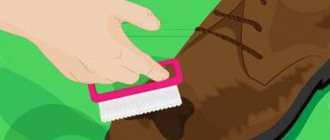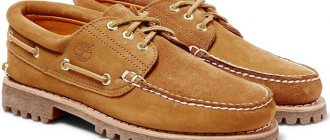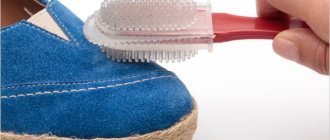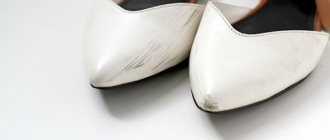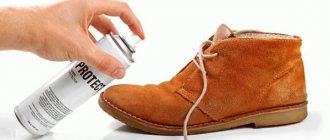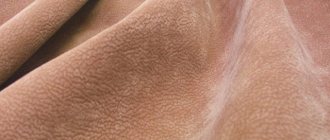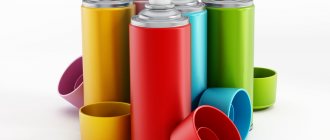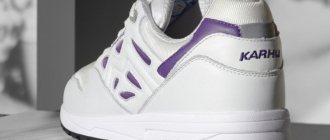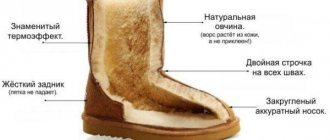This article was prepared by our beloved partners - the #GMfood - an online store of superfoods and craft eco-products.
Just for registering in the store you will receive 300 rubles to your personal bonus account and 2 more interesting gifts (Grab your gifts here)In the store's assortment you will find not only superfoods, but also healthy sweets, breakfasts, herbal teas, peanut butter, master classes for body health and facial beauty, and this is only a small part of the goodies and benefits!
Subscribe to Instagram #GMfood using this link and regularly receive new PP recipes with superfoods, see useful guides to the world of proper nutrition, and also look for gifts hidden under the link in the profile!
What is the difference between natural suede and artificial suede?
Suede shoes require special attention, so you need to know how to properly care for suede shoes. When buying suede shoes, you need to understand how to distinguish natural suede from artificial ones.
Suede is a soft, velvety leather produced by fat and formaldehyde-fat tanning of animal skins. Usually lacks a facial layer.
Source Wikipedia
Here are a few main differences:
- Natural suede smells like leather, while its substitute smells like paint and glue;
- For the production of natural suede, high-quality raw materials are used - animal skin. The process of tanning leather is long and complex, so suede shoes are expensive;
- Shoes made of natural suede may get wet on the top, but moisture will not get inside. Its surface swells and becomes impenetrable;
- The skin is velvety on both sides, there is no fabric base;
- When you run your finger over the pile, it changes color, and the fibers tilt at a certain angle;
- In finished products, the edges are not folded and you can immediately determine from the cut that the suede is natural. In products made from artificial suede, the edges are folded and stitched so that they do not fray;
- The surface of natural suede is never smooth. Its structure is porous with small defects;
- Things made from natural suede are very warm and at the same time “breathe”;
- If you put your hand on natural suede, the material immediately becomes warm.
What kind of material is suede?
Animal skin is subjected to special treatment; fish, seal or bone fat, and vegetable oils are used as tanning agents. The result is a soft, velvety on both sides and very durable material - suede, from which shoes, clothes, bags and accessories are sewn. Things made from it look original, stylish and expensive.
Suede happens:
- natural. For its production, only high-quality expensive raw materials are used: elk, deer, and roe deer leather. The process of dressing and processing is long and complex, so such products are high in price;
- artificial. Only a professional can distinguish it from the natural one by appearance. This is a special fleecy fabric treated with various impregnations for strength, water resistance and color retention. But it does not have durability and allows water to pass through, which is quite cold in winter.
Caring for suede shoes at home
Shoes made of natural suede are expensive and in order for them to last a long time and maintain their original appearance, they must be looked after. This is not at all difficult, but you can extend its wear life.
Suede shoes cannot be worn in rainy weather because they do not tolerate dampness. You should take special care of suede shoes in winter. At this time, in large cities, roads are treated with chemicals, which negatively affects the material of shoes.
Processing new shoes
When purchasing suede shoes, also purchase a special spray that will protect the shoes from moisture and dirt. You should treat your shoes with this spray before going outside. Shoe cleaning should also be repeated periodically during wear.
Treat the surface of new shoes with a soft brush. Then apply a waterproofing spray to keep moisture out of the suede. Let it dry completely. Try to stay away from heat sources.
Apply the spray again and let it dry.
You can go outside in these shoes only after they are completely dry. And this will take about a day.
Suede care products
To care for suede, you need to purchase protective and auxiliary products:
- Water repellent spray;
- Impregnation. Just like the spray, it has protective functions against moisture, dirt, and salt. For suede, impregnation based on fluorocarbon resin is best suited;
- Foam cleaner. Used for gentle and gentle cleaning. Apply to shoes by spraying and remove with a sponge;
- Dye. Protects from dirt and moisture, hides damage. Refreshes and renews color;
- Shoe shampoo;
- Stretcher. You have to walk around in your shoes so that they stretch over your feet;
- Brushes. Hard – used to remove dust and dirt. Eraser – for removing grease stains. Crepe - to restore velvety.
With the right choice, sprays will protect your shoes from slush and make them easier to care for in the future. Suede absorbs the spray well, it is evenly distributed over the entire surface and prevents moisture and street dirt from entering. The only drawback of sprays is that almost all of them have a pungent odor and you have to ventilate the room after cleaning your shoes.
You should choose a brush with short and soft bristles so as not to damage the suede. To clean heavy stains and to avoid damaging the suede structure, it is better to use alcohol-based solutions.
To clean suede, you can use a brush in the form of a hard porous sponge. If the dirt has not yet been absorbed, then such a brush in combination with cleansing foam will easily remove it.
To remove large stains, use an eraser brush. It easily removes greasy residue from the surface of shoes.
After cleaning, a crepe brush will help restore the velvety feel of the pile.
Handy products for caring for suede shoes
If you don’t have special cleaning products for suede shoes on hand, you can use other methods:
- Steam cleaning. To do this, you can use a steam generator. And if it is not there, another method will do. Boil water, pour it into a basin and hold your shoes over the steam until they are slightly wet. Then wipe it with a dry cloth
- Cleaning using ammonia. This mixture will help remove shine and remove dirt. Dilute it in clean water in a ratio of 1:4 (one part ammonia and 4 parts water). Soak a soft sponge in the resulting solution and gently rinse the shoes without rubbing the solution into the suede. After this, wipe with a dry cloth.
Can suede be ironed?
Modern models of jackets are made from various fabrics, which include both natural and synthetic fibers. At the same time, one model can hang in a closet for months without wrinkles, while another model develops unsightly wrinkles already in the second week of storage.
The jacket should be ironed taking into account the characteristics of the fabric. For example, any housewife knows that ironing polyester with a high-temperature iron is dangerous for the product. Synthetics melt quickly when exposed to high temperatures.
Let's look at the properties of the materials from which jackets are made and the methods for ironing them.
Bologna
Bolognese fabric is a type of synthetic fabric that is often used for sewing outerwear (raincoats, jackets, overalls). Bologna is more durable than cotton fabric, and at the same time half the weight of cotton. In addition, Bologna does not allow moisture to pass through, which makes it an ideal material for demi-season jackets.
Bologna jacket
Bolognese fabric practically does not wrinkle. However, often after long-term storage sharp wrinkles form, which are not easy to get rid of. If the housewife does not know how to iron a bologna jacket and is armed with an iron, then everything can end sadly for the product.
You can smooth bologna effectively and safely by:
- ferry;
- iron;
- dry cleaning or laundry services.
Each of these methods requires caution and has its own nuances. Features of using various smoothing methods are presented in the table.
| Ironing method | Image | Description |
| Steam |
| The jacket must be hung on hangers, buttoned and placed in the bathroom (for example, on a clothesline above the bathtub). After this, you need to start filling the bath with hot water. The steam emanating from the water will help gradually smooth out the wrinkles. The procedure must be carried out with the door closed and for 15 minutes. The product is dried at room temperature. |
| Iron |
| Bologna should be treated like silk, so the iron is set to the minimum temperature setting with a steam effect. The jacket must be turned inside out before ironing. The fabric is ironed through damp gauze; it is not recommended to press the iron or hold it in one place for a long time. |
| Dry cleaning |
| Many dry cleaners and laundries are ready to solve the problem of ironing delicate fabrics. If the housewife is not ready to save on her favorite things and does not have time to “tinker” with capricious fabric, then dry cleaning will be the ideal solution. In addition to ironing, professionals can clean and wash the product. |
Suede is a beautiful natural or artificial material that requires delicate care. Suede jackets look beautiful and attractive, and with proper care they can last for quite a long time.
Suede jacket
Housewives disagree on the question of how to iron a suede jacket. It is known that it is not advisable to iron suede. However, some women, without losing the appearance of the product, effectively iron suede through the fabric by setting the iron’s thermostat to “one.”
This method does not guarantee straightening of creases, and in addition, there is a risk of ruining the item, since suede “shrinks” under the influence of temperatures. It is important to study the tag on the product before deciding to iron suede. If dry cleaning and ironing are prohibited, then it is better not to risk it.
It is important to read the tag
On the other hand, suede should absolutely not be wetted, much less washed. In this case, the item is more likely to deteriorate.
Thus, we can offer the most effective and safe methods for ironing suede jackets:
- steam generator or iron in steam mode;
- naturally on hangers (within 2-3 days) or when worn;
- steam from hot water (for example, in the bathroom, as in the case of bologna).
We suggest you familiarize yourself with How to clean a black artificial stone sink
Steam generator
After the jacket has been steamed, it must be cleaned with a dry brush to remove excess moisture. Then it is recommended to hang the jacket on hangers.
Leatherette
Leatherette is a cheap and popular material for making clothing and accessories. This material is based on cotton fabric or synthetics. Due to its soft structure, leatherette is susceptible to the formation of folds and creases.
Leatherette jacket
Fashionistas are probably wondering how to smooth out a dermantine jacket, because clothes made from cheap leatherette on a cotton basis still remain popular. If the product needs ironing, then an iron is best suited for this purpose. However, when ironing you should follow a few simple rules:
- You can iron only from the wrong side;
- the front parts of the jacket (leatherette side) should not touch each other (fabric can be laid);
- it is necessary to set the iron to the lowest temperature setting;
- You cannot iron the product in steam mode (the steam must be turned off);
- Under no circumstances should you iron a leatherette item from the front side.
Another way to use an iron to smooth leatherette products involves steam mode. To do this you need:
- turn the jacket inside out and hang it on hangers;
- insert rolled up towels into the sleeves;
- heat the iron, set the steam mode;
- keeping a distance of 10-20 cm, steam the product with an iron (release steam, move from top to bottom);
- leave to dry.
Steaming with an iron
You can iron your jacket without using an iron. Options for such ironing are presented in the table.
| What is necessary | Description | Photo |
| Water | Turn the jacket inside out and spray it evenly with water from a spray bottle (the water should not run off the fabric). Hang the product on a hanger and straighten the folds with your hands. |
|
| Glycerol | Soak a clean cotton rag in glycerin and treat the wrinkled part of the jacket. Repeat the procedure several times, and then hang the product on hangers. |
|
| Vinegar solution | Mix laundry softener, vinegar and water in equal proportions. Pour the resulting mixture into a spray bottle and spray it onto the product from the front side. Hang the jacket on a hanger and leave for 1 hour. Wipe any resulting stains with a damp cloth. |
|
How to care for suede boots
You need to clean suede shoes after every trip outside so that dust and dirt do not have time to be absorbed. If this happens, it will be difficult to clean the shoes. If the weather is clear, then it will be enough to simply clean your shoes with a special suede brush.
If the weather is rainy and the shoes are wet, then they must first be dried. Moreover, this must be done in natural conditions, and under no circumstances should it be placed near a heater or radiator. In this case, the suede may warp and the shoes will lose their attractive appearance.
After the shoes are dry, they should be cleaned with a suede brush. It performs 2 functions at once - it removes dust and raises lint. If you don’t have such a brush, you can use a school eraser.
How to remove salt from suede shoes
You should start treating your shoes after they have dried.
There are several ways to deal with salt.
You can prepare the mixture: 0.5 tsp. ammonia, 1 tbsp. l. Dilute liquid soap in a glass of water and foam. Apply the resulting mixture with a sponge to the contaminated area. After some time, remove the foam with a soft cloth. After this, wipe the shoes with a solution prepared from 1 liter of water and 1 tbsp. l. vinegar and let the shoes dry.
Salt stains from suede shoes can be removed with steam.
If the shoes are very dirty and the stains cannot be removed, pick up a can of paint that matches the color of the shoes and return them to their original appearance.
How to clean dirt from shoes
Before you decide to clean your suede shoes, remember that dirt can only be removed from dry suede. To prevent your shoes from losing their shape after cleaning, push some paper inside and place them to dry away from heating devices.
After the shoes are dry, remove dirt from their surface with a stiff brush. You can lift the pile with the rubber side of the brush.
What if, for example, glue got on the suede? You can remove it with a cloth soaked in gasoline and only if the glue has not yet hardened. And if it has already dried, you can try to carefully scrape it off with a blade and wipe the dirty area with nail polish remover.
If grease gets on the suede, you can remove it with dishwashing liquid. To do this, mix a small amount of liquid with water, beat until foamy and apply to the stain. After 1-2 minutes, remove the remaining foam with a soft, dry cloth.
Advice and recommendations from experts
Be sure to study all the tips on how to care for suede shoes, because they are expensive, and incorrect actions can significantly shorten the life of your favorite boots.
- Try to wear suede shoes in dry weather, they do not like adverse weather conditions: snow, rain, mud.
- Do not use products designed to care for smooth skin.
- Carry out all manipulations with suede only after it has completely dried. To speed up drying, stuff the inside of the shoes with crumpled newspaper and dry only in natural conditions.
- Avoid sunlight, shoes will fade and lose color.
- If you don’t have a special brush for suede at home, then use folk methods: remove dirt with a crust of rye bread, and for a velvety feel, hold your shoes over hot steam and brush them with a regular clothes brush.
- Do not make circular movements with the brush, this will damage the material. Cleaning should be done using movements in one direction.
- Glycerin perfectly removes salt stains.
- For white shoes, you can use regular toothpaste. It will perfectly remove stains from suede. Ammonia and hydrogen peroxide will help restore the snow-white appearance: add a spoonful to a glass of water and treat the surface.
- At least once a week, apply a protective water-repellent spray to your shoes.
- Under no circumstances should you wash off the dirt with water; it will make the suede dull and the stains will still not disappear.
How to care for light suede shoes
Light-colored shoes get dirty faster, but this does not mean that it is better to refuse them.
To clean it, you need to purchase cleaning foam, brushes or sponges, a spray to protect against moisture, and ammonia. For white shoes you will need hydrogen peroxide.
It is not advisable to wash suede shoes; it is better to simply hold them over steam for 2-3 minutes. After treatment, you need to clean the surface with a special brush.
Heavily soiled shoes can be cleaned with soapy water. In a ratio of 1:5, mix detergent and ammonia with water. After cleaning, wipe the shoes with the solution. To do this, add 1 tsp to 1 liter of water. vinegar essence.
Dirty stains from white suede can be removed with milk. Take a glass of milk, add 2-3 tsp to it. soda and a few drops of ammonia. Soak the brush in this solution and treat the contaminated areas.
Grease stains can be removed with talcum powder, tooth powder or crushed chalk. Sprinkle any of them onto the dirty stain and after a few minutes, brush your shoes with a dry brush.
Summarize
Today we looked at how to sew eco-leather and leatherette.
Main important points:
- properties of materials and difficulties when working with them;
- features and nuances of processing used when cutting and sewing items made of artificial leather.
Next time, you will find an overview of the processing methods used for high-quality sewing of items made of artificial leather, eco-leather and other substitutes.
Let's consider methods and devices that make work easier, as well as alternative options that I have personally tested. Stay tuned for project updates.
Did you like the article? Share with friends, send to your social media feed. networks to return to it at a convenient time.
I'm always glad to hear your comments.
Note:
Please note that some pictures of sewing accessories are clickable. By clicking on them, you will learn details about each tool.
How to care for black suede boots
Suede shoes are always popular because they go well with any clothing - a business suit, dress, skirt, trousers.
But many women are wary of buying it because suede is a capricious material. If you don’t take care of such shoes, dirt, dust, and slush will quickly ruin them.
Suede shoes require daily care.
How to properly clean black suede boots
To care for suede shoes at home, you need to purchase a special shampoo, brushes, and cleaning spray.
First, you need to carefully clean your shoes with soapy water. To prepare it, you need to add liquid soap or regular shampoo to the water. Beat the solution until foamy. Do not use bleaching or coloring agents.
Shoes must be handled carefully to prevent them from getting too wet. Otherwise, when it dries, the skin will become rough and lose its hairiness. It is best to wipe with a foam sponge. Once dipped in the solution, you can squeeze it out to get rid of excess water. After washing, shoes should be wiped with a dry cloth and left to dry.
You can clean your shoes using steam. To clean heavily soiled areas, you can use refined gasoline. There will be no harm from this, because gasoline evaporates quickly. And the area that was cleaned should be wiped with a damp cloth.
To clean suede shoes, you need to have a special cleaning spray at home that has a water-repellent effect.
Differences between natural and artificial suede: what to look for
Natural suede is a noble material obtained during the processing of leather; artificial suede only imitates it. However, the similarities between the materials are so strong that you need to take a closer look so as not to make a mistake with your choice.
Goat, deer, and sheep skins are the main materials from which natural suede is made. The process of obtaining artificial tissue is described above.
And now in detail about the differences that exist between the two types:
- natural material looks natural, you can find small scratches left after processing on it, the porous structure is clearly visible;
- the fabric is sometimes not painted exactly evenly due to uneven textures;
- the sense of smell will also not fail you with the difference in fabrics: the smell of leather comes from the natural base, while from eco-suede it smells like synthetics;
- the thickness of natural fabric is not the same everywhere;
- You must definitely smooth the pile with your hand: in the original fabric, at the point of contact, it will acquire a light shade;
- the price also varies significantly: natural linen is expensive, artificial linen is always much cheaper.
We suggest you familiarize yourself with How to remove rust and corrosion from a car with your own hands
Knowing what kind of material suede is, you will never confuse it with other fabrics that are similar in appearance: velvet, velor.
How to properly store suede shoes
In order for shoes to retain their original appearance for a long time, in addition to caring for them, they must also be stored correctly.
After the end of the season, the shoes must be cleaned, dried, and sprayed with a coloring spray to preserve the color. If there are stains, remove them using one of the above methods.
For suede shoes, it is best to purchase special lasts, which are sold in many shoe stores. They will help maintain the shape of your shoes. The tops cannot be folded, because If creases appear, it will not be possible to eliminate them in the future. If you can’t find the pads, you can use plain paper and stuff your boots or shoes tightly with it. Suede shoes should be stored in a fabric bag.
The main difficulties when working with eco-leather:
- Punctures from the needle remain on the material. Traditional basting with a needle and thread or pinning is not suitable. It will also not work to secure the pattern pieces with the usual pins;
- The surface of the face layer does not allow the sewing machine foot to move easily without “sticking.” The foot does not move, the needle stitches in one place, which leads to severe punctures and “chewing” of the material;
- on the front side of the material using conventional means - soap or chalk. They are hard to see;
- Many types of artificial leather It is strictly forbidden to iron from the front side and from the back. You can easily fuse the top layer or the entire material without the possibility of recovery.
These features require the use of unusual processing methods. Let's look at the main points that you should pay attention to when working with leather substitutes.
